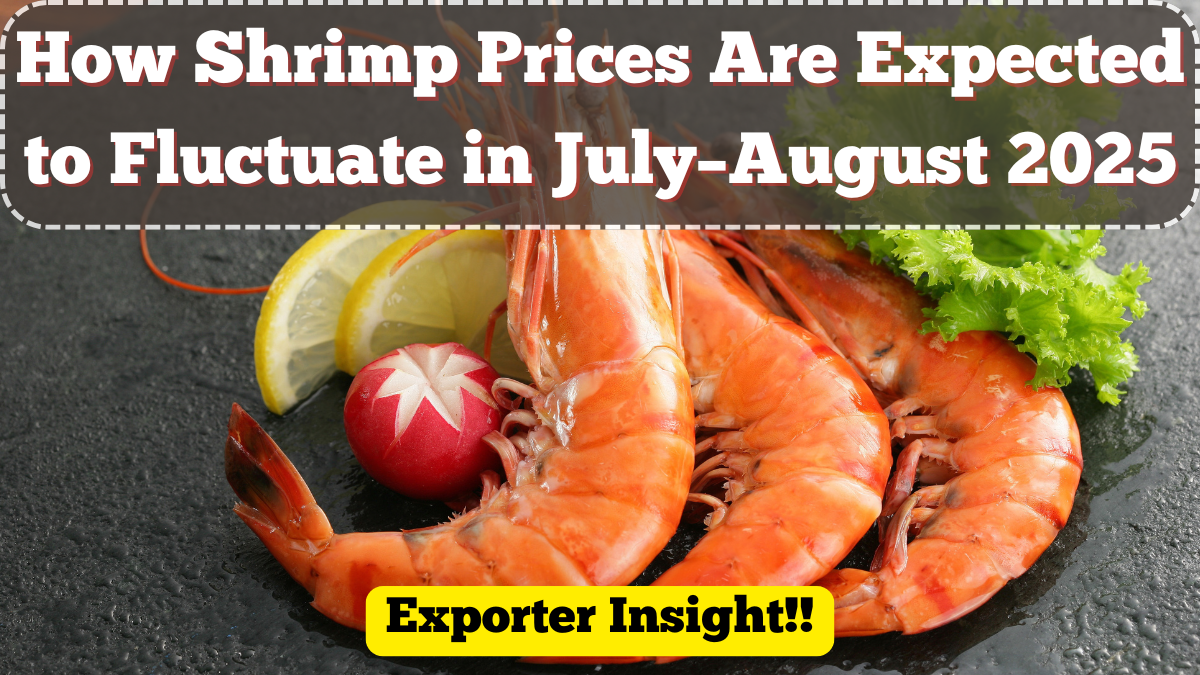As we enter the second half of 2025, the shrimp price trend in India has started showing significant shifts driven by export demand, farming output, and global trade dynamics. Mid-year price movements are crucial for seafood exporters, aquaculture farmers, and processing units that depend heavily on seasonal cycles.
In July and August, India’s shrimp-producing regions—particularly Andhra Pradesh, Odisha, and Tamil Nadu—enter a high-export window. With global buyers preparing for the year-end seafood season, demand for Indian shrimp traditionally spikes, influencing domestic and international prices. Exporters must now closely monitor the shrimp price trend to make informed decisions and optimize their trade strategy.
Let’s look at the current market scenario and what it means for stakeholders.

July 2025 Shrimp Prices: Strong Start to Q3
The shrimp price trend for July has already revealed a notable upward movement, particularly for vannamei and black tiger shrimp varieties. The following are average ex-farm prices recorded in major farming belts:
| Shrimp Size (Count/kg) | July Avg Price (INR/kg) | Change vs June |
|---|---|---|
| 30 count | ₹420 | +₹20 |
| 40 count | ₹390 | +₹18 |
| 60 count | ₹345 | +₹15 |
| 100 count | ₹280 | +₹10 |
Key reasons behind the July shrimp price trend surge include:
-
High overseas orders from the US and China.
-
Delayed harvesting in some areas, causing supply tightening.
-
Depreciation of the Indian Rupee making exports more profitable.
Exporters and brokers are reporting improved margins, while processors are adjusting contracts to factor in the new price band.
Expected Price Movements in August 2025
As August begins, most traders believe the shrimp price trend will continue upward, albeit with minor fluctuations due to weather variability and logistics issues during monsoons. The following drivers will influence pricing in August:
-
Rising freight rates during the peak export season.
-
Increased cold chain costs due to extended storage needs.
-
Government quality checks slowing supply chain turnover.
-
Higher feed and farming input costs pushing up farmer expectations.
Despite these cost pressures, exporters remain optimistic. Bulk orders from Japan and the Middle East for festive seasons are expected to create a support base for stable or slightly higher prices in late August.
Export Market Reactions and Global Demand Outlook
India remains one of the world’s top shrimp exporters, and global buyers closely follow the shrimp price trend in Indian markets. Here’s how importing nations are responding:
-
USA: Demand for frozen peeled shrimp is stable; buyers are booking in advance to lock in current rates.
-
China: Active in bulk purchases; expected to increase imports in late August.
-
EU: Prices remain negotiable, but certification and traceability remain strict.
Exporters dealing with premium categories are leveraging the firm shrimp price trend to secure long-term contracts at better rates, especially for value-added shrimp products.
Challenges Faced by Exporters Despite Price Strength
While the shrimp price trend is currently favorable, exporters are dealing with a few challenges:
-
Delays at container ports due to congestion.
-
Costlier ice and fuel due to monsoon supply disruptions.
-
Demand volatility in smaller markets like Korea and Taiwan.
To mitigate these, exporters are diversifying logistics options and using dynamic pricing models to remain competitive while protecting profits.
Best Practices to Navigate the Price Trend
Exporters and seafood businesses should implement the following strategies in July–August:
-
Monitor real-time auction rates and farmer-supplier pricing daily.
-
Lock-in high-volume orders with fixed-price agreements.
-
Invest in efficient cold chain systems to reduce holding costs.
-
Expand into high-margin export markets using data-driven forecasting.
Staying proactive and informed will allow stakeholders to fully benefit from the current shrimp price trend.
FAQs
What is the average shrimp price in July 2025?
Prices for 30-count vannamei shrimp are averaging ₹420 per kg in major farming states, showing a ₹20 increase compared to June.
Why are shrimp prices rising in 2025?
High export demand, currency depreciation, and delayed harvesting are key reasons for the upward shrimp price trend this season.
Will shrimp prices go down in August 2025?
No significant drop is expected. Prices may stabilize or rise slightly depending on global demand and weather conditions.
How are exporters responding to the current trend?
Many exporters are locking in orders early and negotiating better rates with buyers from the US, China, and Japan.
Are shrimp exports profitable in mid-2025?
Yes, with rising prices and strong international demand, many exporters are experiencing healthy profit margins this season.
Click here to know more.
